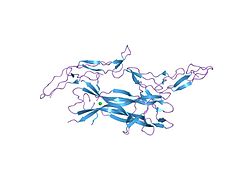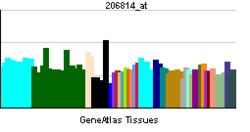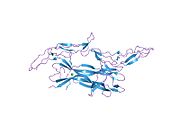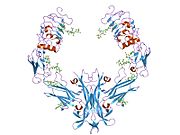- Nerve growth factor
-
Nerve growth factor (NGF) is a small secreted protein that is important for the growth, maintenance, and survival of certain target neurons (nerve cells). It also functions as a signaling molecule.[1][2] It is perhaps the prototypical growth factor, in that it is one of the first to be described. While "nerve growth factor" refers to a single factor,[3] "nerve growth factors" refers to a family of factors also known as neurotrophins.[4] Other members of the neurotrophin family that are well recognized include Brain-Derived Neurotrophic Factor (BDNF), Neurotrophin-3 (NT-3), and Neurotrophin 4/5 (NT-4/5).
Contents
Function and mechanism of action
NGF is critical for the survival and maintenance of sympathetic and sensory neurons. Without it, these neurons undergo apoptosis.[5] Nerve growth factor causes axonal growth. Studies have shown that it causes axonal branching and a bit of elongation.[6] NGF binds with at least two classes of receptors: the p75 LNGFR (for "low-affinity nerve growth factor receptor") neurotrophin receptor (p75(NTR)) and TrkA, a transmembrane tyrosine kinase. Both are associated with neurodegenerative disorders.
NGF binds to high-affinity tyrosine kinase receptor TrkA. This phosphorylates TrkA, which leads to the activation of PI 3 Kinase, ras, and PLC signaling pathways.
There is evidence that NGF circulates throughout the entire body and is important for maintaining homeostasis.[7]
There is also evidence that shows that the precursor to NGF, pro-NGF, may also play important roles due to its abundance. These include apoptotic and neurotrophic properties.[8]
Structure
The structure of NGF was first solved by X-ray crystallography and published in 1991 by McDonald et al in Nature.[9][10] NGF forms a cystine knot structure made up of beta strands twisted around each other and linked by disulfide bonds. Most structures are dimeric. At the time this structure was solved, this fold had never been seen before. Hence NGF is the founding member of the nerve growth factor family of structurally conserved proteins.
History
Rita Levi-Montalcini and Stanley Cohen discovered NGF in the 1950s while faculty members at Washington University in St Louis. However, its discovery, along with the discovery of other neurotrophins, was not widely recognized until 1986, when it won the Nobel Prize in Physiology or Medicine.[11][12][13]
Studies in 1971 determined the primary structure of NGF. This eventually led to the discovery of the NGF gene.
Medical significance
NGF has the potential to help treat several diseases of the nervous system. It has shown this through numerous clinical trials. It has been shown to reduce neural degeneration.[14] It has also been shown to promote peripheral nerve regeneration in rats.[15]
There is strong evidence demonstrating more NGF is expressed in inflammatory [16] conditions. This may one day be used for the treatment of Multiple Sclerosis.[17] Also, it could possibly promote myelin repair.[18]
Also, NGF has been shown to play a role in number cardiovascular diseases, such as coronary atherosclerosis, obesity, type 2 diabetes, and metabolic syndrome.[19] Reduced plasma levels of NGF and BDNF have been associated with acute coronary syndromes and metabolic syndromes.[20][21] NGF could also be related to various psychiatric disorders, such as dementia, depression, schizophrenia, autism, Rett syndrome, anorexia nervosa, and bulimia nervosa.[22] NGF has also been shown to accelerate wound healing. There is evidence that it could be useful in the treatment of skin ulcers and cornea ulcers. [23]
NGF is known to have insulinotropic, angiogenic, and antioxidant properties. NGF suppresses food intake.
It has also been tied to Alzheimer's disease.[24][25][26]
Cultural significance
In 2005, Enzo Emanuele and coworkers at University of Pavia found that nerve growth factor (NGF) has high levels when people first fall in love, but these levels return to as they were after one year. To be specific, four neurotrophin levels, i.e., NGF, BDNF, NT-3, and NT-4, of 58 subjects who had recently fallen in love were compared with levels in a control group who were either single or already engaged in a long-term relationship. The results showed that NGF levels were significantly higher in the subjects in love than as compared to either of the control groups.[27][28][29]
Pietro Calissano has suggested that nerve growth factor may contribute to increased longevity and mental capacity.[30] Centenarian Rita Levi-Montalcini has been taking a daily solution in the form of eye drops, and has stated that her brain is more active now than it was four decades ago.[31]
Interactions
Nerve growth factor has been shown to interact with TrkA[32][33][34] and Low affinity nerve growth factor receptor.[32][33]
See also
- Protein targeting
- Nervous System
- VGF Nerve Growth Factor-inducible, a protein whose expression is induced by NGF
- neurotrophin
- growth factor
- brain-derived neurotrophic factor
- neurotrophin-3
- neurotrophin-4
- nerve growth factor receptor
- Hericium erinaceus an edible mushroom that has been shown to boost NGF
- Huperzine A an herb-derived alkaloid that seems to boost NGF
References
- ^ Fiore M, Chaldakov GN, Aloe L (2009). "Nerve growth factor as a signaling molecule for nerve cells and also for the neuroendocrine-immune systems". Rev Neurosci 20 (2): 133–45. PMID 19774790.
- ^ Purves D, Augustine G, Fitzpatrick D, Hall W, LaMantia A, McNamara J, White L (2004). Neuroscience. Sunderland, Mass: Sinauer. pp. 72–173, 600–606. ISBN 0-87893-725-0.
- ^ MeSH Nerve+Growth+Factor
- ^ MeSH Nerve+Growth+Factors
- ^ Freeman RS, Burch RL, Crowder RJ, Lomb DJ, Schoell MC, Straub JA, Xie L (2004). NGF deprivation-induced gene expression: after ten years, where do we stand?. "NGF and Related Molecules in Health and Disease". Prog. Brain Res.. Progress in Brain Research 146: 111–26. doi:10.1016/S0079-6123(03)46008-1. ISBN 9780444514721. PMID 14699960.
- ^ Madduri S, Papaloïzos M, Gander B (September 2009). "Synergistic effect of GDNF and NGF on axonal branching and elongation in vitro". Neurosci. Res. 65 (1): 88–97. doi:10.1016/j.neures.2009.06.003. PMID 19523996.
- ^ Levi-Montalcini R (2004). "The nerve growth factor and the neuroscience chess board". Prog. Brain Res. 146: 525–7. PMID 14699984.
- ^ Fahnestock M, Yu G, Coughlin MD (2004). ProNGF: a neurotrophic or an apoptotic molecule?. "NGF and Related Molecules in Health and Disease". Prog. Brain Res.. Progress in Brain Research 146: 101–10. doi:10.1016/S0079-6123(03)46007-X. ISBN 9780444514721. PMID 14699959.
- ^ PDB 1bet; McDonald NQ, Lapatto R, Murray-Rust J, Gunning J, Wlodawer A, Blundell TL (December 1991). "New protein fold revealed by a 2.3-A resolution crystal structure of nerve growth factor". Nature 354 (6352): 411–4. doi:10.1038/354411a0. PMID 1956407.
- ^ "NGF - twenty years a-growing". Quips. Protein Data Bank Europe. http://www.ebi.ac.uk/pdbe-apps/quips?story=NGFstory.
- ^ The 1986 Nobel Prize in Physiology or Medicine for discoveries of growth factors
- ^ Presentation Speech by Professor Kerstin Hall The Nobel Prize in Physiology or Medicine 1986
- ^ Rita Levi-Montalcini – Nobel Lecture
- ^ Tuszynski M., Blesch A. (2004). Nerve growth factor: from animal models of cholinergic neuronal degeneration to gene therapy in Alzheimer’s disease. Progress in Brain Research, 146, 0079-6123
- ^ Sun W, Sun C, Lin H, Zhao H, Wang J, Ma H, Chen B, Xiao Z, Dai J (September 2009). "The effect of collagen-binding NGF-beta on the promotion of sciatic nerve regeneration in a rat sciatic nerve crush injury model". Biomaterials 30 (27): 4649–56. doi:10.1016/j.biomaterials.2009.05.037. PMID 19573907.
- ^ Freund V, Frossard N (2004). Expression of nerve growth factor in the airways and its possible role in asthma. "NGF and Related Molecules in Health and Disease". Prog. Brain Res.. Progress in Brain Research 146: 335–46. doi:10.1016/S0079-6123(03)46021-4. ISBN 9780444514721. PMID 14712791.
- ^ Villoslada P, Genain CP (2004). Role of nerve growth factor and other trophic factors in brain inflammation. "NGF and Related Molecules in Health and Disease". Prog. Brain Res.. Progress in Brain Research 146: 403–14. doi:10.1016/S0079-6123(03)46025-1. ISBN 9780444514721. PMID 14699976.
- ^ Althaus HH (2004). Remyelination in multiple sclerosis: a new role for neurotrophins?. "NGF and Related Molecules in Health and Disease". Prog. Brain Res.. Progress in Brain Research 146: 415–32. doi:10.1016/S0079-6123(03)46026-3. ISBN 9780444514721. PMID 14699977.
- ^ Chaldakov GN, Fiore M, Stankulov IS, Manni L, Hristova MG, Antonelli A, Ghenev PI, Aloe L (2004). Neurotrophin presence in human coronary atherosclerosis and metabolic syndrome: a role for NGF and BDNF in cardiovascular disease?. "NGF and Related Molecules in Health and Disease". Prog. Brain Res.. Progress in Brain Research 146: 279–89. doi:10.1016/S0079-6123(03)46018-4. ISBN 9780444514721. PMID 14699970.
- ^ Chaldakov GN, Fiore M, Tonchev AB, Dimitrov D, Pancheva R, Rancic G, Aloe L (2007). "Homo obesus: a metabotrophin-deficient species. Pharmacology and nutrition insight". Curr. Pharm. Des. 13 (21): 2176–9. doi:10.2174/138161207781039616. PMID 17627549.
- ^ Manni L, Nikolova V, Vyagova D, Chaldakov GN, Aloe L (June 2005). "Reduced plasma levels of NGF and BDNF in patients with acute coronary syndromes". Int. J. Cardiol. 102 (1): 169–71. doi:10.1016/j.ijcard.2004.10.041. PMID 15939120.
- ^ Chaldakov G., Tonchev A., Aloe L. (2009). NGF and BDNF: from nerves to adipose tissue, from neurokines to metabokines. Relevance to neuropsychiatric and cardiometabolic.
- ^ Kawamoto K, Matsuda H (2004). Nerve growth factor and wound healing. "NGF and Related Molecules in Health and Disease". Prog. Brain Res.. Progress in Brain Research 146: 369–84. doi:10.1016/S0079-6123(03)46023-8. ISBN 9780444514721. PMID 14699974.
- ^ Counts S, Mufson E (2005). "The role of nerve growth factor receptors in cholinergic basal forebrain degeneration in prodromal Alzheimer disease". J Neuropathol Exp Neurol 64 (4): 263–72. PMID 15835262.
- ^ Hempstead B (2006). "Dissecting the diverse actions of pro- and mature neurotrophins". Curr Alzheimer Res 3 (1): 19–24. doi:10.2174/156720506775697061. PMID 16472198.
- ^ Allen S, Dawbarn D (2006). "Clinical relevance of the neurotrophins and their receptors". Clin Sci (Lond) 110 (2): 175–91. doi:10.1042/CS20050161. PMID 16411894.
- ^ Emanuele E, Politi P, Bianchi M, Minoretti P, Bertona M, Geroldi D (2005). "Raised plasma nerve growth factor levels associated with early-stage romantic love". Psychoneuroendocrinology 31 (3): 288–94. doi:10.1016/j.psyneuen.2005.09.002. PMID 16289361. link
- ^ "NGF" gives passionate lovers just one year, Reuters, November 29, 2005.
- ^ John Harris Is love just a chemical?, Guardian, November 29, 2005.
- ^ Peter Popham (2009-04-25). "Is this the secret of eternal life?". London: The Independent. http://www.independent.co.uk/news/science/is-this-the-secret-of-eternal-life-1674005.html.
- ^ Popham, Peter (April 25, 2009). "Is this the secret of eternal life?". The Independent (London). http://www.independent.co.uk/news/science/is-this-the-secret-of-eternal-life-1674005.html.
- ^ a b Nykjaer, Anders; Lee Ramee, Teng Kenneth K, Jansen Pernille, Madsen Peder, Nielsen Morten S, Jacobsen Christian, Kliemannel Marco, Schwarz Elisabeth, Willnow Thomas E, Hempstead Barbara L, Petersen Claus M (Feb. 2004). "Sortilin is essential for proNGF-induced neuronal cell death". Nature (England) 427 (6977): 843–8. doi:10.1038/nature02319. PMID 14985763.
- ^ a b Lee, R; Kermani P, Teng K K, Hempstead B L (Nov. 2001). "Regulation of cell survival by secreted proneurotrophins". Science (United States) 294 (5548): 1945–8. doi:10.1126/science.1065057. ISSN 0036-8075. PMID 11729324.
- ^ Wiesmann, C; Ultsch M H, Bass S H, de Vos A M (Sep. 1999). "Crystal structure of nerve growth factor in complex with the ligand-binding domain of the TrkA receptor". Nature (ENGLAND) 401 (6749): 184–8. doi:10.1038/43705. ISSN 0028-0836. PMID 10490030.
External links
PDB gallery 1bet: NEW PROTEIN FOLD REVEALED BY A 2.3 ANGSTROM RESOLUTION CRYSTAL STRUCTURE OF NERVE GROWTH FACTOR1btg: CRYSTAL STRUCTURE OF BETA NERVE GROWTH FACTOR AT 2.5 A RESOLUTION IN C2 SPACE GROUP WITH ZN IONS BOUND1sg1: Crystal Structure of the Receptor-Ligand Complex between Nerve Growth Factor and the Common Neurotrophin Receptor p751www: NGF IN COMPLEX WITH DOMAIN 5 OF THE TRKA RECEPTOR2ifg: Structure of the extracellular segment of human TRKA in complex with nerve growth factorEndocrine system: hormones (Peptide hormones · Steroid hormones) Endocrine
glandsTestis: testosterone · AMH · inhibin
Ovary: estradiol · progesterone · activin and inhibin · relaxin (pregnancy)
Placenta: hCG · HPL · estrogen · progesteroneIslet-Acinar
AxisNon-end.
glandsThymus: Thymosin (Thymosin α1, Thymosin beta) · Thymopoietin · Thymulin
Digestive system: Stomach: gastrin · ghrelin · Duodenum: CCK · GIP · secretin · motilin · VIP · Ileum: enteroglucagon · peptide YY · Liver/other: Insulin-like growth factor (IGF-1, IGF-2)
Adipose tissue: leptin · adiponectin · resistin
Kidney: JGA (renin) · peritubular cells (EPO) · calcitriol · prostaglandin
Heart: Natriuretic peptide (ANP, BNP)Cell signaling: nervous tissue: neurotrophin Trk binding GFL Other Growth factors Fibroblast EGF-like domain TGFβ pathway Insulin-like Platelet-derived Vascular endothelial Other Nerve · HepatocyteB trdu: iter (nrpl/grfl/cytl/horl), csrc (lgic, enzr, gprc, igsr, intg, nrpr/grfr/cytr), itra (adap, gbpr, mapk), calc, lipd; path (hedp, wntp, tgfp+mapp, notp, jakp, fsap, hipp, tlrp) Synuclein Other Agrin · Chimerin · Granin (Chromogranin A, B) · FMR1 · Gap-43 protein · GLUT3 · Myelin · Brain natriuretic peptide · Nerve growth factor · SCG5 · Neurogranin · Neuronal calcium sensor · Neuropeptide · Olfactory marker protein · S-100 protein (Calgranulin) · Synapsin (1, 2, 3) · Synaptophysin · Tubulin · GPM6ACategories:- Human proteins
- Neurotrophins
- Peptide hormones
- Growth factors
- Developmental neuroscience
- Proteins
Wikimedia Foundation. 2010.







